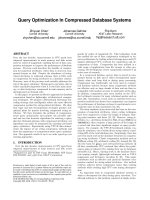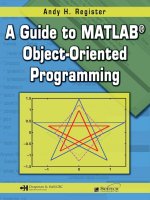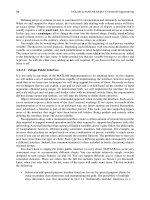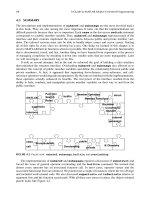2. a Query Optimization in Object Oriented Databases 2012
Bạn đang xem bản rút gọn của tài liệu. Xem và tải ngay bản đầy đủ của tài liệu tại đây (558.78 KB, 5 trang )
Volume 2, Issue 2, February 2012
ISSN: 2277 128X
International Journal of Advanced Research in
Computer Science and Software Engineering
Research Paper
Available online at: www.ijarcsse.com
Query Optimization in Object Oriented Databases through
Detecting Independent Subqueries
Ms. M.C. Nikose
Computer Science & Engineering
Sipna’s College of Engg & Tech.
Amravati, Maharashtra.
India.
Ms. S.S. Dhande
Computer Science & Engineering
Sipna’s College of Engg & Tech.
Amravati, Maharashtra.
India
Dr. G. R. Bamnote
Computer Science & Engineering
P.R.Meghe Institute of Tech. & Research
Badnera, Maharashtra.
India
Abstract - Query optimization is the refining process in database administration and it helps to bring down speed of execution. Some
object-oriented languages allows to express queries explicitly in the code, which are optimized using the query optimization techniques
from the database domain. With respect to this, a formalized object query language (OQL) has been developed that performs optimization
of queries at compile time. Object Oriented Data Base (OODB) has all the features, functionality of a relational database system and also
offers an Object Oriented Programming language interface. We follow the stack based approach to query languages, which is responsible
for naming-scoping-binding principle. In this paper we proposed one of the methods of query optimization depending on rewriting.
Optimization by rewriting concerns queries containing so called independent subqueries. It consists in detecting them and then factoring
outside the loops implied by query operators.
Keywords: OQL, Object Oriented Database, Stack Based Approach, Rewriting, Query Optimization.
I.
INTRODUCTION
During the last two decades, Relational Database
Management System (RDBM) has been established as the
technology, handling databases up to terabytes. Relational
DBMSs have been extremely successful in the market;
however RDBMS lack the mechanisms to deal with
complex structured data. Their tabular approach does not
allow a suitable modeling of complex hierarchical objects.
Most of the applications such as Geographical Information
System, CAD, Multimedia, and Engineering etc. are
characterized by having to manage complex, highly
interrelated information, which was difficult to manage in
RDBMS. To combat the limitations of RDBMS and meet
the challenge of the increasing rise of the internet and the
Web, programmers developed object-oriented databases in
1980 [7].
In recent years, database research has concentrated on
object-oriented data models, which allow to store highly
structured data. With regard to the data structuring
concepts offered, an object-oriented data model can be
looked upon as an extension of the nested relational model,
[5] which allows to store relations as attribute values.
However, the relational model only permits the alphanumeric
data management. A similar role in object-oriented database
is fulfilled by object query languages (OQL). The
usefulness of these languages strongly depends on query
optimization. With growing complexity of data structuring
concepts, the complexity of the accompanying query
language grows as well and thus also the complexity of
query processing and optimization.
For the correct and precise formalization of object
query language the concept of naming-scoping-binding
paradigm must take into consideration. Hence we fallow
the Stack Based Approach (SBA). Analyzing query
processing in the Stack Based Approach (SBA) [3], it can
be observed that some subqueries are evaluated many times
outside the loops implied by the non-algebraic operators
despite that in subsequent loop cycles there results are
same. Such subqueries can be processed only once and
their result can be used in next loop cycles. This
observation is a basis for our proposed method called
factoring out independent subqueries. The underlying idea
used here is that, if none of the name in subquery is bound
in the ES section opened by the non-algebraic operator
currently being evaluated, then this subquery is
independent of this operator. This means that subquery can
be factored out of that operator, i.e., executed outside its
iteration loop.
II.
OVERVIEW OF OODBMS
An OODBMS is the result of combining object
oriented
programming
principles
with
database
management principles. Object oriented programming
concepts such as encapsulation, polymorphism and
inheritance are enforced along with regular database
management concepts such as the Atomicity, Consistency,
Isolation and Durability (ACID properties) which lead to
system integrity, support for an ad hoc query language and
secondary storage management systems which allow for
Volume 2, issue 2, February 2012
managing very large amounts of data.. OODB [6] is a
system while supporting all the functionality of a relational
database system (including queries, transactions, backup
and recovery mechanisms), also offers an Object oriented
programming language interface, user defined data types,
object identifiers and the ability to manage objects
persistently. Features that are common in the RDBMS
world such as transactions, the ability to handle large
amounts of data, indexes, deadlock detection, backup and
restoration features and data recovery mechanisms also
exist in the OODBMS world. Following figure shows the
features of Object oriented Database [8].
A
primary feature of an OODBMS is that accessing objects in
the database is done in a transparent manner such that
interaction with persistent objects is no different from
interacting with in-memory objects.
www.ijarcsse.com
networks and object programming languages. They aim to
permit the reuse of structures and operations to construct
some more complex entities. [4] Data are represented in the
basis as of objects. Associations are implemented by the
direct ties via object identifying that permit a fast
navigational access between the different objects. Indeed, a
query must use the new concepts introduced by object
model [3]. The class is a data abstract type permitting to
define properties of a whole of objects regrouped in two
categories: attributes and operations [5][6].The object is a
triplet <OID, class, state>, the OID is identifying of the
object. It's unique and invariant during the program. The
attribute is defined by its name and its type. An operation
is a function that permits to modify the state of an object or
to send back a value. The inheritance is a transmission
mechanism of properties of a class toward one under class.
The inheritance is simple if the property is inherited of
only one on-class. It is multiple when the property is
present in several on-classes. The polymorphism is the fact
to arrange operations having one same name but of the
different parameters in number or in types.
Fig 1. Features of OODBMS
Fig 2. Optimization Process
Database operations typically involve obtaining a
database root from the OODBMS which is usually a data
structure like a graph, vector, hash table, or set and
traversing it to obtain objects to create, update or delete
from the database. When a client requests an object from
the database, the object is transferred from the database
into the application's cache where it can be used either as a
transient value that is disconnected from its representation
in the database or it can be used as a mirror of the version
in the database in that updates to the object are reflected in
the database and changes to object in the database require
that the object is refetched from the OODBMS.
III.
QUERY OPTIMIZATION IN OODBMS
Query optimization in relational databases is benefited
a lot from the simplicity of the data model. This is not the
case with the object model. The object-oriented data model
is a generalization of the relational one and is believed to
eliminate many of its flaws through incorporating modern
concepts. Object models are descended of the semantic
© 2012, IJARCSSE All Rights Reserved
Most of the query optimization methods are based on
query rewriting [9]. Rewriting means transforming a query
q1 into semantically equivalent query q2 promising much
better performance. It consists in detecting parts of query
matching some patterns. When it is recognized, a query is
rewritten according to the predefined rewriting rule. The
advantage of rewriting is that algorithm are fast, such
optimization is compile time optimization entirely
performed before query is executed, hence query
optimization process itself does not burden the
performance. Process of optimization is summarizes in
three steps shown in figure 2 Rewrite step consists in a
syntactic and semantic rewrite of the query in the goal to
determine simpler equivalent queries [1]. The result of this
step is the generation of a query graph. Ordering
operations step is takes place in two phases: generation and
assessment of the plans which determined in the first
Volume 2, issue 2, February 2012
phase. Execution step permits to choose the optimal
execution plan and to execute it
IV. STACK BASED APPROACH
The Stack-Based Approach (SBA) is a formal frame
addressing
object-oriented
database
query
and
programming languages (PLs). The approach is motivated
by the belief that there is no definite border line between
querying and programming; thus there should be a
universal theory that uniformly covers both aspects. SBA
allows [3] to precisely determine the semantics of query
languages; there relation with object oriented concepts,
with imperative programming constructs and with
programming abstraction, including procedures, functional
procedures views, modules etc. its main features are the
following
The naming-scoping-binding principle is assumed,
which means that each name occurring in a query
is bound to the appropriate run-time entity (an
object, attribute, method, parameter, etc.)
depending upon the scope for the name.
One of its basic mechanisms is an environmental
stack (ENVS). The stack is responsible for scope
control, for binding names, parameter passing and
procedure calls. ENVS is also responsible for
processing non-algebraic query operators.
The object relativity principle is assumed, i.e.
object on any hierarchy level have same formal
properties and are treated uniformly. This
principle simplifies semantic considerations in
developing query optimization methods.
For objects the principle of internal identification
is assumed; each run-time entity that can be
separately bound, inserted, updated, deleted etc.
must possess a unique internal identifier.
In all programming language the naming-scopingbinding issue leads to the mechanism, internal data
structure called as Environmental Stack (ENVS)[1],[2]. It
employs abstraction principle, which allows the
programmer to consider the currently rewritten piece of
code to be independent of the context of its possible use.
Hence safe nesting of procedure calls is assured, including
any recursive calls. ENVS is subdivided into sections,
which are ordered, with newest section known as top and
oldest one as bottom. A section is associated with a
particular procedure call or an executed program block.
The stack consists of sections that are sets of binders.
Binder is a concept that allows us to explain and describe
various naming issues that occur in object models and
programming languages. At the beginning, the ENVS
consist of single section containing binders to all root
database objects. During query evaluation the stack is
growing and shrinking according to query nesting. Here we
assume a small database schema shown below in fig 3.It
defines five classes as Person, Professor, Student, Lecture
and Faculty. Names of classes are followed by cardinality
© 2012, IJARCSSE All Rights Reserved
www.ijarcsse.com
numbers, unless the cardinality is [1….1].Queries are
combined by operators. All the operators use for joining a
query are either unary or binary. Binary operator is
subdivided into algebraic and non-algebraic. The main
difference between them is that whether they modify the
state of ENVS during evaluation or not.
Fig. 3 Database Schema
An operator is algebraic if it does not modify the state
of ENVS. The algebraic operators include numerical and
string operators and comparisons, Boolean and, or, not,
aggregate function, and sequence operators and
comparisons, structure constructor, etc. Operators which
name a query result are unary algebraic operators too. The
operator group as names the entire query result, while as
names each element in a sequence or bag returned by the
query. If q1 Δ q2 be a query consisting of two subqueries
connected by a binary algebraic operator Δ. The eval
procedure takes q1 and pushes its result onto top of QERS
then does the same with q2 , performs Δ with two top
QRES values and finally removes top of QRES twice and
pushes the final result onto top.
If query q1 Ɵ q2 involves a non-algebraic Ɵ, then q2
is evaluated in the context of q1. The context is determined
by the new section opened by the Ɵ operator on ENVS for
an element of q1. A new stack section pushed onto ENVS
is constructed by a special function. Subqueries q1 and q2
cannot be processed independently, the order of evaluation
is important. Non-algebraic operators include projection
/navigation (q1.q2), selection (q1 where q2), dependent
join (q1 join q2), quantifiers (Ǝq1q2), transitive closure and
ordering.
V. BASIC IDEA OF PRPOSED METHOD
In this paper we are proposing one of the methods of
query optimization. The idea of this method is based upon
the observation that, if none of the name in subquery is
bound in the ENVS section opened by the non-algebraic
operator currently being evaluated, then this subquery is
independent of this operator. Subqueries are called
independent if they can be evaluated outside loops implied
by the non-algebraic query operators. Such subqueries are
worth analyzing because they usually imply optimization
possibilities [1],[5].We use a special technique called the
method of independent subqueries to optimize queries.
Volume 2, issue 2, February 2012
Technically, it consists in analyzing in which sections
particular names occurring in a query are bound. It turns
out that if none of the names in given subquery is bound in
the scope opened by the non-algebraic operator currently
being evaluated, then that subquery can be evaluated earlier
than it results from its textual place in the query it is a part
of. The method modifies the textual form of a query so that
all its subqueries will be evaluated as soon as possible. To
determine in which scopes names occurring in a query are
bound at run time [10], we statically analyze that query and
during analyzing we additionally do the following:
Each non-algebraic operator is assigned the
number of the scope it opens,
Each name in the query is assigned two numbers:
The stack size: the number of scopes thst
is on static ENVS when the binding of
this name is being performed.
The binding level: the number of the
scope on the stack in which this name is
bound.
All those numbers are determined relatively to the
bottom scopes of a query. Thus, for instance the binding
level for a free name (names that are bound in the bottom
scopes) is 1, and for non-free name (names that are not
free) is greater than 1. The independent subquery method
consists in analyzing the number of those ENVS section in
which particular names occurring in a query are bound.
For example, consider a simple query “Get lectures whose
credits are greater than the credits of physics”
Lecture where credits >
((Lecture where subject =”physics”).credits)
(1)
Here the subquery returning the credits of physics:
(Lecture where subject =”physics”).credits
(2)
Is evaluated for each Lecture object existing in the
database, while it is enough to calculate it just once,
because its evaluation gives the same result every time. We
can say that this subquery is independent of its direct nonalgebraic operator. Let us see how the number are assigned
to query,
Lecture where credits >
(1, 1)
2
(2,2)
((Lecture where subject =”physics”).credits)
(2,1)
3
(3,3)
3 (3,3)
As shown above none of the names in subquery (2) is
bound in section 2 opened by external where, therefore
subquery (2) is independent of that operator and can be
calculated before it opens its section. To express it in the
textual form of the query, the independent subquery is
factored out this is done in following ways,
A new unique auxiliary name is chosen. It will be used
as the name of the result of the independent subquery
(2).
Then the subquery (2) is named by the as operator, put
before the entire subquery (1) of the non-algebraic
operator it is independent of, and connected to the rest
of the query (i.e. 3) by a dot operator.
© 2012, IJARCSSE All Rights Reserved
www.ijarcsse.com
Finally, the auxiliary name is put in the previous place
of (2) this subquery. After factoring subquery (2) out,
query (1) will be rewrite as
(((Lecture where subject =”physics”).credits) as c).
(1,1)
2
(2,2)
2 (2,2)
2
Lecture where credits > c
(3)
(2,1) 3
(3,3) (3,2)
Where c is the auxiliary name. Now subquery (2) is
evaluated before its result is used and the auxiliary name c
naming its result makes it possible to read this result. The
method of independent subquery is quite sophisticated , it
recursively traversed a query abstract syntax tree(AST) to
find the largest subquery which is independent of the
currently evaluated non-algebraic operator. After detecting
such subquery AST is reorganized according to the
rewriting rule. The process is repeated until all independent
subqueries are discovered and rewritten.
VI.
CONCLUSION
The necessity to support complex data in databases
is intensified. Models trying to answer to these needs
appeared as the object-oriented and the object relational
model. The relational model only permits the alphanumeric
data management. To combat the limitations of RDBMS
and meet the challenge of the increasing rise of the internet
and the Web, programmers developed object-oriented
databases. In this paper we discuss some basic concepts
and features of OODBMS. We present a new optimization
method for queries involving independent subquery. More
powerful variants of the method were received on the
assumption concerning the distributive property of
selection, projection/navigation and dependent join. Due
this property we can develop extended version of query
rewriting methods known from the relational model, in
particular, pushing selection before a join.
REFERENCES
[1][JPlod00] J. Płodzień, A. Kraken, “Object Query Optimization through
Detecting Independent Subqueries”,
Information Systems, Elsevier
Science, 25(8), 2000, pp. 467-490.
[2][Mich09] Michel Bleja, Krzysztof Stencel, Kazimierz Subeita,
“Optimization of Object-Oriented Queries Addressing Large and Small
Collections”, Proc. Of the IMCSIT, 2009, ISBN 978-83-60810-22-4, Vol.
4, pp. 643-680.
[3][Subi95] K.Subieta, C.Beeri, F.Matthes, J.W.Schmidt. “A Stack-Based
Approach to Query Languages”. Proc.2nd East-West Database
Workshop, 1994, Springer Workshops in Computing, 1995, 159-180.
[4][MA05]Minyar Sassi, and Amel Grissa-Touzi “Contribution to the
Query Optimization in the Object-Oriented Databases” World Academy
of Science, Engineering and Technology 11 2005
[5][G99]G. Gardarin, “Object and relational databases” , Eyrolles, 1999.
[6] [RC 94]R.G.G. Catell, “Object-Oriented Data Management: ObjectOriented and Extended Relational Database Sytems”, Addison-Wesley
Publishing, Inc., 1994.
[7] Sunanda Luthra “Architecture In Object Oriented databases
”Lecturer, Department of CSE/IT Amritsar College of Engg. & Tech,
Amritsar.143001,Punjab, India .
[8] David Maier “Object-Oriented Database Theory An Introduction &
Indexing in OODBS”
Volume 2, issue 2, February 2012
[9][Plod00] J. Plodzien, “Optimization Methods in Object query
Languages”, Ph. D. Thesis, Institute of Computer Science, Polish
© 2012, IJARCSSE All Rights Reserved
www.ijarcsse.com
Academy of Sciences, 2000.









